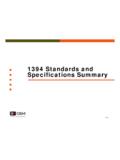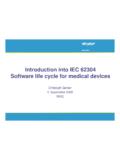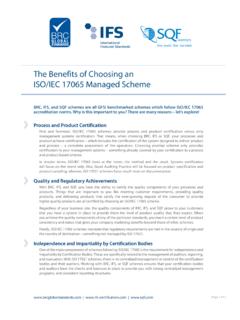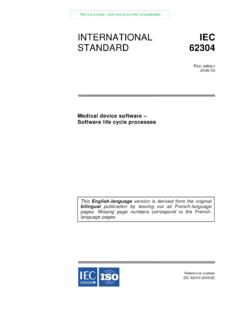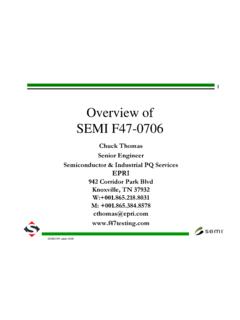Transcription of RESEARCH REPORT 216 - Health and Safety Executive
1 HSE Health & Safety Executive A methodology for the assignment of Safety integrity levels (SILs) to Safety - related control functions implemented by Safety - related electrical, electronic and programmable electronic control systems of machines Prepared by Innovation Electronics (UK) Ltd and the Health & Safety Laboratory (HSL) for the Health and Safety Executive 2004 RESEARCH REPORT 216 HSE Health & Safety Executive A methodology for the assignment of Safety integrity levels (SILs) to Safety - related control functions implemented by Safety - related electrical, electronic and programmable electronic control systems of machines Mark Charlwood BSc Innovation Electronics (UK) Ltd 21 Dean Lane Hazel Grove Stockport SK7 6DH Shane Turner BSc MSc PhD CPhys MInstP Health & Safety Laboratory Broad Lane Sheffield S3 7HQ Nicola Worsell BSc MSc Health & Safety Laboratory Broad Lane Sheffield S3 7HQ This contract RESEARCH REPORT describes the development by the authors, with funding from HSE, of a methodology for the assignment of required Safety Integrity Levels (SILs) of Safety related electrical control systems of machinery.
2 The rationale behind the methodology and how to use it in practice are also explained in some detail. The methodology has been developed and accepted for inclusion in an informative annex of the International Electrotechnical Committee standard IEC 62061: Safety of Machinery Functional Safety of Electrical, Electronic and Programmable Electronic Control Systems for Machinery currently being drafted. This REPORT and the work it describes were funded by the Health and Safety Executive (HSE). Its contents, including any opinions and/or conclusions expressed, are those of the authors alone and do not necessarily reflect HSE policy. HSE BOOKS Crown copyright 2004 First published 2004 ISBN 0 7176 2832 9 All rights reserved. No part of this publication may be reproduced, stored in a retrieval system, or transmitted in any form or by any means (electronic, mechanical, photocopying, recording or otherwise) without the prior written permission of the copyright owner.
3 Applications for reproduction should be made in writing to: Licensing Division, Her Majesty's Stationery Office, St Clements House, 2-16 Colegate, Norwich NR3 1BQ or by e-mail to ii ACKNOWLEDGEMENTS The authors would like to acknowledge the considerable input to this project from the rest of the project team: Steve Frost from HSE, Colin Chambers and Jill Wilday from HSL. The authors would also like to acknowledge the help from Tom Treble in putting together and running the workshop presented to members of the IEC/TC44/WG7 when work first began on the development of this methodology. iii iv CONTENTS 1 1 2 Background.
4 2 IEC 62061 and its relationship with IEC Functional Safety and Safety integrity levels ..3 Risk assessment and risk reduction in the machinery sector Emerging risk assessment methodologies for machinery ..6 SIL assignment methodologies in other sectors ..8 Recognised deficiencies in machine risk assessment practice ..10 3 Objectives .. 12 4 SIL assignment 14 Introduction ..14 Overview of the Preparation Step 1 ..16 Safety function analysis and mapping Step Identification of potential accidents Step 3 ..19 Accident scenario frequency estimation for NFS accidents Step Accident scenario frequency estimation for FT accidents Step 5 ..24 Harm frequency estimation Step 6 ..25 Harm frequency summation Step 7.
5 27 SIL assignment Step Plausibility check and sensitivity ..32 5 Assumptions implicit in the SIL assignment methodology .. 35 6 36 Comparison with other User tests ..36 summary of validation ..37 7 38 8 40 9 41 Appendix A: Instructions for use ..41 Appendix B: Copy of forms included in Annex A of IEC 62061 ..57 Appendix C: Relating risk to 10 References .. 69 v vi Executive summary Objectives This contract RESEARCH REPORT describes the development by the authors, with funding from HSE, of a methodology for the assignment of required Safety Integrity Levels (SILs) of Safety related electrical control systems of machinery. The rationale behind the methodology and how to use it in practice are also explained in some detail.
6 The methodology has been developed and accepted for inclusion in an informative annex of the International Electrotechnical Committee standard IEC 62061: Safety of machinery Functional Safety of electrical, electronic and programmable control systems for machinery currently being drafted. Main Findings A quantified, structured and systematic methodology has been developed for assigning SILs to SRECS Safety functions in machinery. This has been developed and accepted for inclusion in IEC 62061 as an informative annex. Appendices in this REPORT provide draft copies of the instructions for use for this methodology and the associated forms that are intended for inclusion in the informative annex. The methodology encourages the documentation of assumptions and takes into account the risk reduction measures provided by other technologies.
7 This methodology is only one route to the decision as to the most appropriate SIL and is available for use when there are no machinery specific standards or codes of practice upon which to base this decision. From the validation carried out and the workshop held for members of Technical Working Group IEC/TC44/WG7 the following conclusions could be drawn about use of the methodology: it is difficult to use to assign SILs to functions related to emergency stops. An addendum to the methodology is required to explain both types of use of emergency stop equipment (in an emergency and as a high integrity manual stop) and to provide additional guidance in assigning SIL to the related functions.
8 The paper format, in the use of forms, can appear unwieldy and inefficient. This is also out-of-date in modern CAD based design offices, which may make put off commercial users. The methodology needs to be developed into a self-documenting software based system to overcome these issues. the methodology appears complex which may also put users off. However, the complexity is necessary in ensuring that people think properly about the way an accident develops. Additionally, the methodology captures the full range of harm outcomes without being overly pessimistic. This adds some complexity, but avoids over-estimation of the risk and an onerous SIL being assigned. the guidance on the datum event for NFS type accidents is insufficiently clear.
9 Overall, the methodology was fount to be fit-for-purpose and usable, and generated SILs that appeared sensible. The complexity of the methodology is offset by clear step-by-step instructions that lead the user through the completion of the forms. If followed carefully whilst completing the forms the task is not too onerous. But if the user attempts to fill in the forms without proper reference to the vii instructions mistakes can easily be made. A number of minor changes to the instructions and from box descriptors have, however, been identified in the process of writing this REPORT that would improve their clarity. This SIL allocation methodology assists the machinery sector to assign SILs using a rigorous, structured and transparent risk based approach.
10 The forms also provide a detailed audit trail. The benefits of the technique outweigh the disadvantages, namely its apparent complexity. Although the methodology has been developed for SIL assignment in the machinery sector, there is no reason why this cannot be expanded to cover SIL assignment in other sectors. The basic approach should be generic across all industries, although some limited development would be required. Certain concepts developed in this work would also be very useful in other areas. For example, the concept of involvement time has application in other sectors, and the combination of person type and involvement time has value for both overall installation risk assessment and deriving individual risk.










